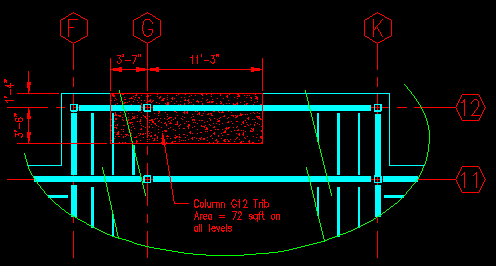|
Limit State of Flexural Buckling for Compact and Non-compact Sections |
|
|
Section 7.8
Example Problem 7.2
Last Revised: 11/04/2014
The example problems presented in this section have a spreadsheet solution. You will need this file to follow along with the presented solutions. You can click on the following link to get the file:
Chapter 7: Excel Spreadsheet Solutions
In addition to the spreadsheet solution this problem also has a downloadable hand solution: BGSCMExample7_2.pdf
Given: In the building drawing set the column located the intersection of grids G & 12 supports some floor, roof, and exterior wall. See drawings BLDG S1 and S2.
Wanted: Select a Round HSS section that may be used at the first floor at this location.
Solution:
The first task in this problem is to identify the portion of the building being supported by the column. In this case, the column is support some of the two floors above, the roof, and part of the exterior wall. (It is assumed for now that the exterior wall is supported at each level.) Figure 7.8.2.1 shows the area, at each level, that is tributary to the specified column. Each level supports 14'-10" of exterior wall.
Figure 7.8.2.1
Tributary Area
Click on image for larger view
The magnitude of the unit loads is obtained from the general notes on the first sheet of the drawing set for the dormitory building. The one exception is the roof snow load. The drawings give the value for the ground snow load. This can be converted to roof snow load as described in A Beginner's Guide to ASCE 7-95. For now we just will use a roof snow load of 50 psf.
There are a number of LRFD and ASD load combinations that could possibly control. The provided spreadsheet solution shows several of these. A more thorough set can easily be investigated.
Once the LRFD and ASD loads (Pu and Pa) are computed, the values for f and W are used to compute a required Pn. In this case, LRFD does not require quite the capacity that ASD does. This is the result of the load being predominately dead load.
The approach taken here is to find a member that works for LRFD then for ASD. The sizes are likely to be close.
To facilitate the search, we have used the electronic shape database provided with the SCM to sort all the round HSS sections by their cross sectional areas. We need only then enter the table, compute the capacity for our first guess then move up or down the table until we find the lightest section that satisfies the strength criteria. This approach has some problems as illustrated in example problem 7.3.
Our first guess (driven by a guess at Fcr then solving for a required Ag) was a bit low, so we then worked up the sorted table to find the best solution.
The LRFD solution results in one member that is close to required value. It is off by only 3%. Given the conservative nature of the unit load determinations and our tributary area analysis, this is probably close enough. However, with a very slight increase in area (and, hence, in weight) we can obtain a section that has a significant increase in capacity. This is probably the better choice.
In the ASD solution, the best section is pretty obvious and it is the same as the one that is recommended for LRFD.
